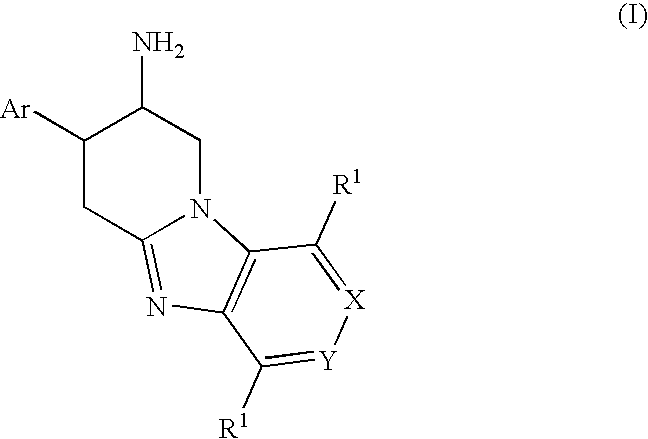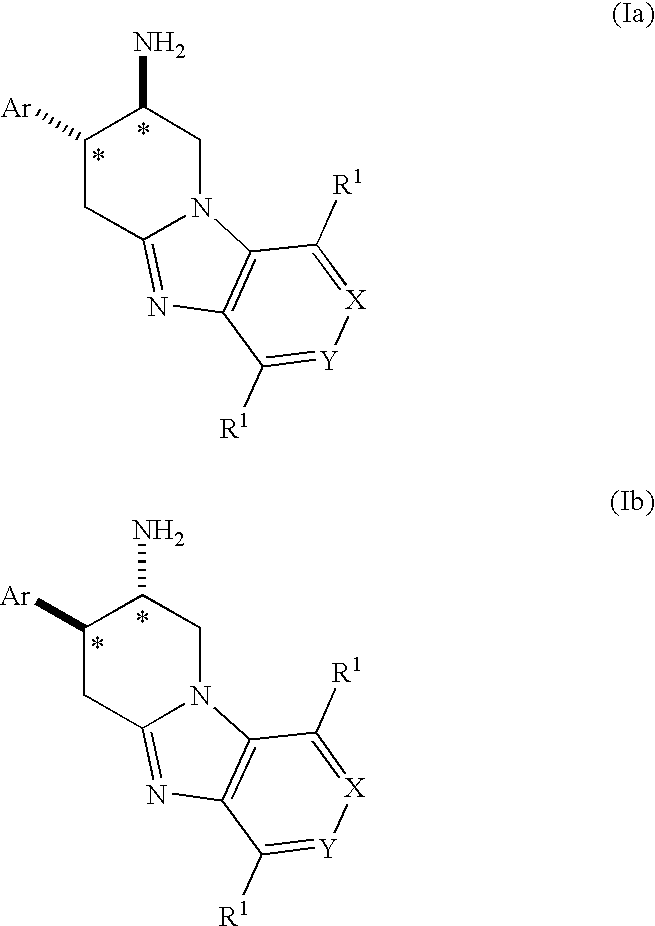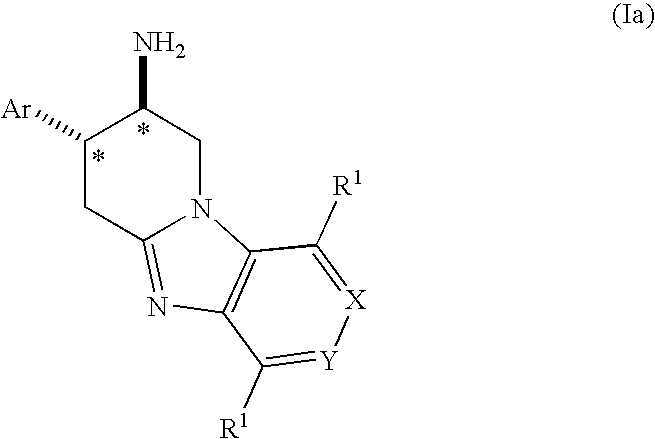Fused Aminopiperidine as Dipeptidyl Peptidase-IV Inhibitors for the Treatment or Prevention of Diabetes
a dipeptidyl peptidase and insulin-iv inhibitor technology, applied in the field of new substituted fused aminopiperidines, can solve the problems of increased and premature morbidity and mortality, increased risk of macrovascular and microvascular complications in patients with type 2 diabetes mellitus, and increased plasma insulin levels
- Summary
- Abstract
- Description
- Claims
- Application Information
AI Technical Summary
Benefits of technology
Problems solved by technology
Method used
Image
Examples
example 1
[0172]
2R,3R)-7-(Pyrrolidin-1-ylcarbonyl)-3-(2,4,5-trifluorophenyl)-1,2,3,4-tetrahydropyrido-[1,2-a]benzimidazol-2-amine bis-trifluoroacetic acid salt
Step A: Methyl 4-[5-[(tert-butoxycarbonyl)amino]-2-oxo-4-(2,4,5-trifluorophenyl)piperidin-1-yl]-3-nitrobenzoate
[0173] An oven-dried flask capped with a septum was charged with 1.0 g (2.9 mmol) of Intermediate 1, 1.1 g (4.4 mmol) of 4-bromo-3-nitrobenzoic acid methyl ester, 49 mg (0.26 mmol) of copper iodide, 700 mg (5.1 mmol) of potassium carbonate and 10 mL of dry toluene. To the resulting suspension was added 0.055 mL (0.51 mmol) of N,N′-dimethylethylenediamine and the mixture was heated to reflux for 16 h. The mixture was next cooled to ambient temperature, then diluted with 100 mL of ethyl acetate and washed sequentially with 1N aqueous hydrochloric acid, saturated aqueous sodium bicarbonate solution, and brine (100 mL each), dried over anhydrous sodium sulfate, filtered, concentrated in vacuo and purified by flash chromatography ...
example 2
[0178]
(2R,3R)-8-(Methylsulfonyl)-3-(2,4,5-trifluorophenyl)-1,2,3,4-tetrahydropyrido-[1,2-a]benzimidazol-2-amine bis-trifluoroacetic acid salt
Step A: 2-Bromo-4-(methylthio)aniline
[0179] To a solution containing 1.0 mL (8.0 mmol) of 4-(methylthio)aniline in 40 mL of a 3:1 solution mixture of acetonitrile / carbon tetrachloride was added 1.6 g (8.8 mmol) of N-bromosuccinimide. The reaction mixture was heated to reflux for 30 min, then cooled to ambient temperature and concentrated in vacuo. To the residue was added 100 mL of ethyl acetate and the organic solution was washed sequentially with saturated aqueous sodium bicarbonate solution and saturated aqueous brine (100 mL each), dried over sodium sulfate, filtered and evaporated in vacuo to yield a viscous oil. The crude material was purified by flash chromatography on a Biotage Horizon® system (silica gel, 0 to 30% ethyl acetate / hexanes gradient) to give the title compound. 1H NMR (CDCl3): δ 7.45 (s, 1H), 7.15 (dd, J=8.3, 2.0 Hz, 1H),...
example 29
[0185]
(7R,8R)-1-Chloro-7-(2,4,5-trifluorophenyl)-6,7,8,9-tetrahydropyrido[4′,3′:4,5]imidazo[1,2-a]pyridine-8-amine tris trifluoroacetic acid salt
Step A: tert-Butyl [(7R,8R)-2-oxido-7-(2,4,5-trifluorophenyl)-6,7,8,9-tetrahydropyrido[4′,3′:4,5]imidazo[1,2-a]pyridin-8-yl]carbamate
[0186] To 48 mg of Boc-protected intermediate from Example 27 in 2 mL of acetone was added m-chloroperbenzoic acid (28 mg). After stirring for 2 h, the reaction mixture was concentrated and the residue was purified by reverse phase HPLC (YMC Pro-C18 column, gradient elution, 0% to 65% acetonitrile / water with 0.1% TFA). The residue was dissolved in ethyl acetate (10 mL), sequentially washed with saturated aqueous sodium bicarbonate solution (5 mL) and brine (5 mL), dried over anhydrous sodium sulfate, filtered and concentrated. LC / MS 435.1 (M+1).
Step B: tert-Butyl [(7R,8R)-1-chloro-7-(2,4,5-trifluorophenyl)-6,7,8,9-tetrahydropyrido[4′,3′:4,5]imidazo[1,2-a]pyridin-8-yl]carbamate
[0187] To the product of Step ...
PUM
| Property | Measurement | Unit |
|---|---|---|
| volume | aaaaa | aaaaa |
| emission wavelength | aaaaa | aaaaa |
| excitation wavelength | aaaaa | aaaaa |
Abstract
Description
Claims
Application Information
 Login to View More
Login to View More - R&D
- Intellectual Property
- Life Sciences
- Materials
- Tech Scout
- Unparalleled Data Quality
- Higher Quality Content
- 60% Fewer Hallucinations
Browse by: Latest US Patents, China's latest patents, Technical Efficacy Thesaurus, Application Domain, Technology Topic, Popular Technical Reports.
© 2025 PatSnap. All rights reserved.Legal|Privacy policy|Modern Slavery Act Transparency Statement|Sitemap|About US| Contact US: help@patsnap.com



